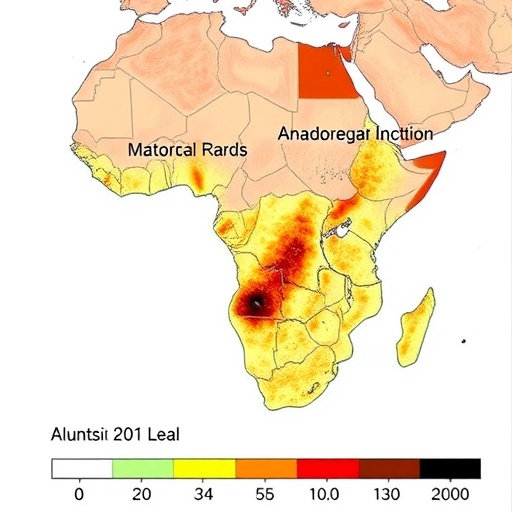In a groundbreaking study published in “Commun Earth Environ,” researchers, led by Jian Piao, explore a pressing concern facing global ecosystems: land aridification in vulnerable dryland regions. As the effects of climate change continue to escalate, the research illuminates a stark reality—despite ongoing climate mitigation strategies, aridification persists, presenting significant threats to agricultural productivity and biodiversity. This article delves into the intricacies of this phenomenon, highlighting the implications of the findings for environmental sustainability and global food security.
The study emerges from an urgent need to understand how land systems are responding to climatic changes alongside efforts to reduce greenhouse gas emissions. With a focus on drylands, which constitute about 40% of the Earth’s terrestrial surface and support over two billion people, the research emphasizes the intersectionality of climate mitigation and land health. These areas are particularly susceptible to disruption, highlighting the importance of investigating their future under various climatic scenarios.
Researchers harnessed advanced modeling techniques to assess the potential impact of climate mitigation scenarios on aridification trends spanning the next few decades. The models reveal that even with significant reductions in emissions, drylands may continue to experience a drying trend. This finding contradicts the assumption that climate mitigation alone will effectively curb aridification processes. The implications of such trends are profound, raising questions about the resilience of agricultural systems and livelihoods in these already vulnerable regions.
Through their analysis, the researchers identified key drivers of land aridification, emphasizing climate variables such as precipitation patterns and temperature changes. The study illustrated that temperature increases could induce further evaporation, exacerbating stress on soil moisture levels. Additionally, shifts in precipitation distribution, with increased variability and intensity, might lead to episodic droughts, further complicating the ecological balance of these ecosystems.
While mitigation measures are vital to stave off the most severe impacts of climate change, the persistence of aridification highlights the critical need for adaptive strategies. The authors argue for a multidimensional approach that integrates climate mitigation with comprehensive land management practices. This could involve promoting sustainable agricultural practices, enhancing soil health, and implementing robust water conservation techniques to help preserve the ecological integrity of dryland regions.
The researchers also underscore that ongoing monitoring and research are imperative for understanding the dynamics of aridification further. Such efforts must be collaborative, drawing on international partnerships and local knowledge to develop tailored responses in affected communities. The potential success of such strategies will depend on equitable governance structures that empower local populations while enhancing resilience against the impacts of climate change.
Moreover, the study paints a sobering picture of the future of food security in dryland regions. As aridification progresses, agricultural yields are likely to decline, compounding existing socio-economic challenges in these areas. The findings indicate a pressing need for innovative agricultural practices that can withstand the twin pressures of climate change and arising shortages. This demand amplifies the urgency for investment in agricultural technology research, exploring drought-resistant crops and advanced irrigation methods to mitigate the adverse effects on food production.
Ecosystem services, which underpin life in drylands, are also at risk, with biodiversity facing unprecedented threats. The research indicates that as the ecological balance shifts due to aridification, species may be forced to adapt rapidly or face extinction. This possibility raises significant conservation challenges, necessitating proactive strategies to protect not just the flora and fauna of these regions but also the cultural and economic practices of the communities that depend on them.
Public policies must evolve to address the realities of aridification, advocating for both mitigation and adaptation strategies. Policymakers are called upon to design frameworks that not only target emission reductions but also provide robust support for communities grappling with the realities of increasingly arid conditions. Engaging stakeholders, from government entities to local farmers, is vital for crafting efficient policies rooted in the lived experiences of those affected.
As the narrative of climate change continues to unfold, studies like this serve as critical reminders of the multifaceted challenges we face. While individual actions play a role in climate mitigation, understanding the regional and global implications of our environmental practices is crucial. The necessity for holistic approaches to combat the persistent phenomenon of aridification cannot be overstated, as our collective future hinges on the health of these fragile ecosystems.
In conclusion, Piao and colleagues’ findings urge us to reconsider our approaches to climate action, emphasizing that mitigation alone may not suffice to halt the tide of aridification in drylands. It is incumbent upon society to embrace integrated strategies that harmonize environmental stewardship with economic development. This research not only serves as a clarion call for scientists and policymakers but also invites a broader dialogue on our responsibility toward the planet and its inhabitants. As we grapple with climate change’s complexities, the importance of sustainable land management and adaptive resilience becomes ever clearer, challenging us to rethink our relationship with the environment.
As we navigate the path forward, we are reminded of the importance of resilience in the face of adversity. The persistence of land aridification under climate mitigation scenarios underscores an urgent call to action for all stakeholders involved. Scientists, policymakers, and local communities must work in unison to devise comprehensive strategies that not only mitigate climate change but also adapt to its inevitably changing realities. Each step taken today can foster a more sustainable future, where both people and nature can thrive.
Subject of Research: Land aridification in drylands under climate mitigation scenarios.
Article Title: Land aridification persists in vulnerable drylands under climate mitigation scenarios.
Article References:
Piao, J., Chen, W., Kug, JS. et al. Land aridification persists in vulnerable drylands under climate mitigation scenarios.
Commun Earth Environ 6, 732 (2025). https://doi.org/10.1038/s43247-025-02742-y
Image Credits: AI Generated
DOI: 10.1038/s43247-025-02742-y
Keywords: Climate Change, Aridification, Drylands, Land Management, Food Security, Ecosystem Services, Sustainable Agriculture, Mitigation Strategies.




